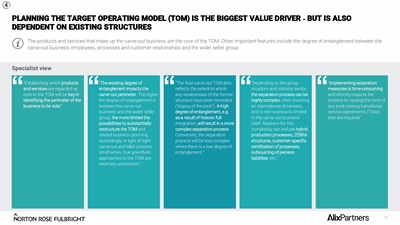
16
Specialist view
PLANNING THE TARGET OPERATING MODEL (TOM) IS THE BIGGEST VALUE DRIVER ˗ BUT IS ALSO
DEPENDENT ON EXISTING STRUCTURES
The products and services that make up the carve-out business are the core of the TOM. Other important features include the degree of entanglement between the
carve-out business, employees, processes and customer relationships and the wider seller group
"Establishing which products
and services are regarded as
core to the TOM will be key in
identifying the perimeter of the
business to be sold."
"The final carve-out TOM also
reflects the extent to which
any weaknesses of the former
structure have been remedied
("legacy of the past"). A high
degree of entanglement, e.g.
as a result of historic full
integration, will result in a more
complex separation process.
Conversely, the separation
process will be less complex
where there is a low degree of
entanglement."
"Implementing separation
measures is time-consuming
and directly impacts the
timeline to closing/the term of
any post-closing transitional
service agreements (TSAs)
that are required."
"Depending on the group
structure and industry sector,
the separation process can be
highly complex, often involving
an international dimension,
and is not necessarily limited
to the carve-out business
itself. Reasons for this
complexity can include hybrid
production processes, ZEBRA
structures, customer-specific
certification of processes,
outsourcing of pension
liabilities, etc."
"The existing degree of
entanglement impacts the
carve-out perimeter. The higher
the degree of entanglement is
between the carve-out
business and the wider seller
group, the more limited the
possibilities to substantially
restructure the TOM and
related business planning.
Accordingly, in light of tight
carve-out and M&A process
timeframes, true greenfield
approaches to the TOM are
relatively uncommon."
4